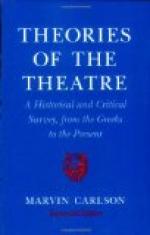V
ECONOMY OF ATTENTION IN THEATRICAL PERFORMANCES
I
According to the late Herbert Spencer, the sole source of force in writing is an ability to economise the attention of the reader. The word should be a window to the thought and should transmit it as transparently as possible. He says, toward the beginning of his Philosophy of Style:
A reader or listener has at each moment but a limited amount of mental power available. To recognise and interpret the symbols presented to him requires a part of this power; to arrange and combine the images suggested requires a further part; and only that part which remains can be used for realising the thought conveyed. Hence, the more time and attention it takes to receive and understand each sentence, the less time and attention can be given to the contained idea; and the less vividly will that idea be conveyed.
Spencer drew his illustrations of this principle mainly from the literature of the library; but its application is even more important in the literature of the stage. So many and so diverse are the elements of a theatrical performance that, unless the attention of the spectator is attracted at every moment to the main dramatic purpose of the scene, he will sit wide-eyed, like a child at a three-ring circus, with his mind fluttering from point to point and his interest dispersed and scattered. A perfect theatrical performance must harmonise the work of many men. The dramatist, the actors main and minor, the stage-manager, the scene-painter, the costumer, the leader of the orchestra, must all contribute their separate talents to the production of a single work of art. It follows that a nice adjustment of parts, a discriminating subordination of minor elements to major, is absolutely necessary in order that the attention of the audience may be focused at every moment upon the central meaning of the scene. If the spectator looks at scenery when he should be listening to lines, if his attention is startled by some unexpected device of stage-management at a time when he ought to be looking at an actor’s face, or if his mind is kept for a moment uncertain of the most emphatic feature of a scene, the main effect is lost and that part of the performance is a failure.




